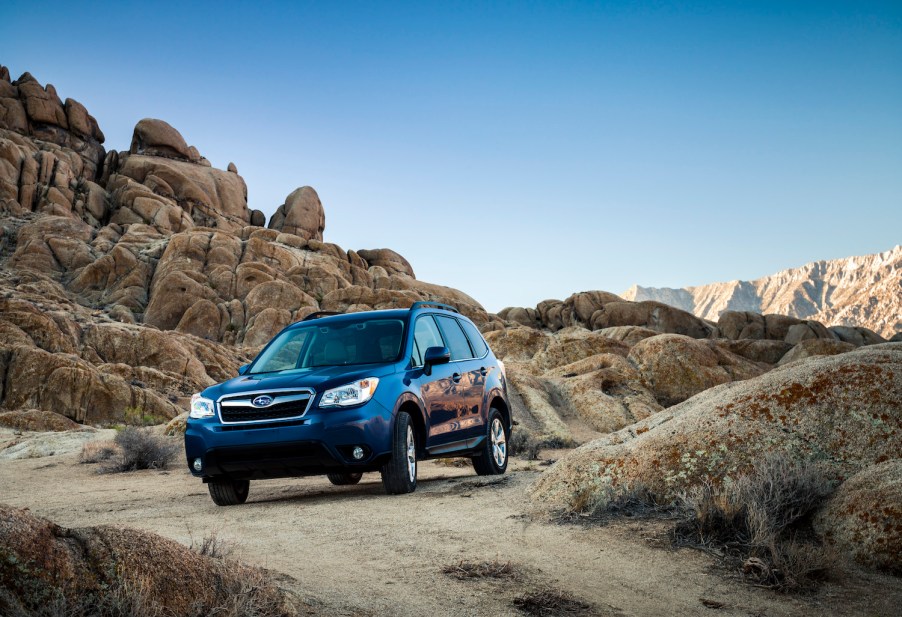
Buying a Used Subaru Forester: Here’s What You Need to Know
The Subaru Forester is beloved by many, and for a good reason. It’s roomy, standard with all-wheel drive, and is well-known for its strong resale value. Further consider its high safety ratings, and it’s hard to deny that the Subaru Forester makes for a great pick among its segment. Naturally, the same goes if you’re in the market for a used car. But there are a few things worth keeping in mind when buying a used Subaru Forester.

Which used Subaru Forester should you buy?
The Subaru Forester has been around for kind of a long time, meaning you’ll have plenty of model years to choose from. But don’t let that overwhelm you when shopping for a used Subaru Forester.
The first generation of Foresters arrived in 1998 and ran until 2002. In 2003, it underwent a redesign, though it didn’t change much for the vehicle. The third-generation Forester arrived in 2009, and according to Autotrader, boasted “a more accommodating rear seat, a larger cargo bay, improved ride and handling and 8.7 inches of ground clearance.” Fourth-generation Foresters arrived in dealerships in 2014 and, in 2019, were followed by the current generation of Forester models.
Per Autotrader’s advice, if your budget is in the $5,000 to $8,500 range, a well maintained second-generation Forester makes for a great pick. If you’re able to spend a bit more, however, Autotrader recommends scooping up a fifth-generation used Forester, preferably 2016 or newer.
Is a used Forester a safe car to drive?
Subaru doesn’t mess around when it comes to safety features. In fact, several model years have been recognized as either a Top Safety Pick or a Top Safety Pick+ by the Insurance Institute for Highway Safety (IIHS).
It’s worth keeping in mind, however, that if you want in on Subaru’s latest driver-assist features, including Subaru EyeSight, it’s worth choosing a newer used Subaru Forester rather than an older one.
The Forester does have some issues
Unfortunately, there are some things you should know about before purchasing a used Forester. First and second-generation models did suffer from head gasket issues. Autotrader reports that if you end up having to replace the head gaskets, it will run you about $2,000-$3,000. However, remedying the problem could buy you another 100,000 miles or more.
According to CarComplaints.com, you should avoid the 2014 Subaru Forester too. The 2014 model suffered from several owner complaints about the vehicle’s engine. Other common complaints concerning the 2014 model include suspension, transmission, and electrical problems.
Buying a certified pre-owned Subaru Forester
If you’re hoping to get the most bang for your buck when buying a used Subaru Forester, consider the benefits of buying a certified pre-owned model. Every certified pre-owned Subaru Forester must undergo a 152-point safety inspection. If anything doesn’t meet Subaru’s high standards, it’s either repaired or replaced.
All certified pre-owned Subaru Forester models are paired with a factory-backed 7-year/100,000-mile powertrain warranty and roadside assistance too. You’ll also enjoy perks like a trial subscription to SiriusXM and a one-year trial subscription to the STARLINK Safety Plus Package with Automatic Collision Notification.
Are there better options out there?
Buying a used Subaru Forester isn’t your only option. Autotrader reports that earlier generations of the Forester competed with models like the Honda CR-V, the Toyota RAV4, and the Ford Escape. Newer models, on the other hand, are often compared to the Volvo XC40, the BMW X3, and the Acura RDX. Depending on how much you’re looking to spend and what types of features you’re after, you should consider taking a gander at those models too.
Is a used Subaru Forester the right pick for you?
The Subaru Forester has a lot going for it. It’s safe, reliable, and, all in all, is just a great car to drive. In the end, if you’re in the market for a pre-owned SUV, you can’t go wrong with a used Subaru Forester.



